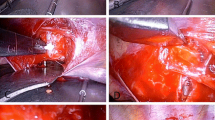Abstract
This article presents an evaluation of fluoroscopy for indirect, posterior reduction and fixation of thoracolumbar burst fractures. A prospective study of 25 patients with thoracolumbar burst fractures who underwent C-arm machine-guided posterior indirect reduction and short segment fixation without fusion is described. No laminotomies were performed. All patients had a mean follow-up of 30.4 months. At postoperative review, the average anterior and posterior vertebral heights were corrected from 57.9% to 99.0% and 89.0% to 99.5%, respectively. The Cobb angle was corrected from 18.4° to 0.17°. The canal compromise ratio was improved from 35.2% to 8.6%. In all 25 cases, neurological status was intact at last follow-up. Fluoroscopy guidance is an effective method to accomplish indirect reduction and fixation. Reduction was confirmed on lateral fluoroscopic views by looking for a “one-line sign,” which is the reconstitution of the posterior border of the vertebral body.
Résumé
L’objectif de cette étude est d’évaluer l’intérêt de l’amplificateur de brillance dans les réductions et les fixations de fractures dorso-lombaires. Matériel et méthode: une étude prospective de 25 patients présentant une fracture dorso-lombaire a été réalisée. Ces patients ont été opérés avec une fixation courte sans greffe et sans laminotomie. Résultats: tous les patients ont eu un suivi moyen de 30,4 mois. Après l’intervention chirurgicale, la hauteur vertébrale a été améliorée respectivement de 57,9%, 89,0% à 99,2% et 99,5%. L’angle de Cobb a été corrigé de 18,4 à 0,17. La largeur du canal vertébral est améliorée de 35,2 à 8,6%. Dans tous ces 25 cas, le statut neurologique des patients est normal au dernier suivi. En conclusion: l’utilisation d’un guidage par amplificateur de brillance est une méthode qui permet de réduire et de fixer de façon satisfaisante ce type de fracture. La réduction est confirmée par le signe « one-line » qui permet d’affirmer la bonne reconstitution du mur vertébral postérieur.





Similar content being viewed by others
References
Altay M, Ozkurt B, Aktekin CN, Ozturk AM, Dogan O, Tabak AY (2007) Treatment of unstable thoracolumbar junction burst fractures with short- or long-segment posterior fixation in magerl type a fractures. Eur Spine J 16(8):1145–1155
Brightman RP, Miller CA, Rea GL et al (1992) Magnetic resonance imaging of trauma to the thoracic and lumbar spine: the importance of the posterior longitudinal ligament. Spine 17:541–549
Butt MF, Farooq M, Mir B, Dhar AS, Hussain A, Mumtaz M (2007) Management of unstable thoracolumbar spinal injuries by posterior short segment spinal fixation. Int Orthop 31:259–264
Cain JE, DeJong JT, Dinenberg AS et al (1993) Pathomechanical analysis of thoracolumbar burst fracture reduction: a calf spine model. Spine 18:1647–1654
Chang KW (1992) A reduction-fixation system for unstable thoracolumbar burst fractures. Spine 17:879–885
Dai LY, Jiang SD, Wang XY, Jiang LS (2007) A review of the management of thoracolumbar burst fractures. Surg Neurol 67(3):221–231
Fredrickson BE, Edwards WT, Rauschning W et al (1992) Vertebral burst fractures: an experimental, morphologic, and radiographic study. Spine 17:1012–1021
Heary RF, Salas S, Bono CM, Kumar S (2006) Complication avoidance: thoracolumbar and lumbar burst fractures. Neurosurg Clin N Am 17(3):377–388
Hitchon PW, Torner J, Eichholz KM, Beeler SN (2006) Comparison of anterolateral and posterior approaches in the management of thoracolumbar burst fractures. J Neurosurg Spine 5(2):117–125
Kirkpatrick JS (2003) Thoracolumbar fracture management: anterior approach. J Am Acad Orthop Surg 11:355–363
Langrana NA, Harten RD, Lin DC, Reiter MF, Lee CK (2002) Acute thoracolumbar burst fractures: a new view of loading mechanisms. Spine 27(5):498–508
Maynard F, Bracken MB, Greasy G et al (1997) International standards for neurological function classification of spinal cord injury. Spinal Cord 35(5):266
Muller U, Berlemann U, Sledge J et al (1999) Treatment of thoracolumbar burst fractures without neurologic deficit by indirect reduction and posterior instrumentation: bisegmental stabilization with monosegmental fusion. Eur Spine J 8:284–289
Mumford J, Weinstein JN, Spratt KF et al (1993) Thoracolumbar burst fractures: the clinical efficacy and outcome of nonoperative management. Spine 18:955–970
Petersilge CA, Emery SE (1996) Thoracolumbar burst fracture: evaluating stability. Semin Ultrasound CT MR 17(2):105–113
Sasso RC, Renkens K, Hanson D, Reilly T, McGuire RA Jr, Best NM (2006) Unstable thoracolumbar burst fractures: anterior-only versus short-segment posterior fixation. J Spinal Disord Tech 19(4):242–248
Tran NT, Watson NA, Tencer AF, Ching RP, Anderson PA (1995) Mechanism of the burst fracture in the thoracolumbar spine. The effect of loading rate. Spine 20(18):1984–1988
Wood KB, Bohn D, Mehbod A (2005) Anterior versus posterior treatment of stable thoracolumbar burst fractures without neurologic deficit: a prospective, randomized study. J Spinal Disord Tech 18(Suppl):S15–S23
Author information
Authors and Affiliations
Corresponding author
Rights and permissions
About this article
Cite this article
Yang, Hl., Shi, Jh., Liu, J. et al. Fluoroscopically-guided indirect posterior reduction and fixation of thoracolumbar burst fractures without fusion. International Orthopaedics (SICOT) 33, 1329–1334 (2009). https://doi.org/10.1007/s00264-008-0626-8
Received:
Revised:
Accepted:
Published:
Issue Date:
DOI: https://doi.org/10.1007/s00264-008-0626-8




